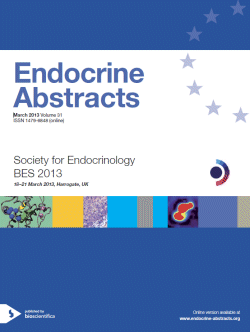Searchable abstracts of presentations at key conferences in endocrinology
ea0031se1.2 | (1) | SFEBES2013
Robert Graves' and his remarkable colleagues
The 19th century saw the emergence of an extraordinarily gifted group of Dublin doctors who enjoy eponymous recognition. Immediately on graduating Robert Graves travelled for over 2 years to many of the foremost medical centres in Europe. On his return he introduced formal bedside teaching and daily lectures which has become the model for clinical training in these islands. Graves main other interest was the treatment of febrile illness recognizing the importance o...
ea0031se1.2 (1) | (1) | SFEBES2013
Robert Graves' and his remarkable colleagues
The 19th century saw the emergence of an extraordinarily gifted group of Dublin doctors who enjoy eponymous recognition. Immediately on graduating Robert Graves travelled for over 2 years to many of the foremost medical centres in Europe. On his return he introduced formal bedside teaching and daily lectures which has become the model for clinical training in these islands. Graves main other interest was the treatment of febrile illness recognizing the importance o...
ea0031se1.3 | (1) | SFEBES2013
Should the aging male become a father?
Couples in developed countries are increasingly delaying child bearing to later in life. While it is well known that female reproductive functions decrease and genetic risks for the offspring increase beyond the age of 35 and seize completely around the age of 50, the influence of risks of paternal age on fertility and offspring are less well known. Indeed, until recently life long fertility was assumed for the male. However, testicular function slowly declines with age and fe...
ea0031se1.4 | (1) | SFEBES2013
Hypovitaminosis-D and the RAS in type 2 diabetes risk
Background: Hypovitaminosis D is associated with T2DM risk, cross-sectionally and prospectively; supplementation can reduce insulin resistance and increase glucose-induced insulin secretion in humans. Increased pancreatic islet RAS activity is induced by hyperglycemia, enhancing β cell damage (Leung PS et al.). Vitamin D is now known to suppress renin secretion, thus we have examined effects of calcitriol on increased islet RAS activity in vitro±hyp...
ea0031se1.5 | (1) | SFEBES2013
Type 1 and type 2 diabetes are the same disorder of insulin resistance, but with different genetic backgrounds
Some 40 years ago, diabetes was re-classified from a single disorder into autoimmune (T1D) and metabolic (T2D) on the interpretation of observation rather than the outcome of experiment. The 20 or so experiments carried out since to test the autoimmune hypothesis (largely randomised trials of immunotherapy) have proved disappointing, and none has translated into patient benefit. There is arguably reason to question the autoimmunity paradigm. The accelerator hypothesis argues t...
ea0031se1.6 | (1) | SFEBES2013
Suspicious hypoglycaemia; was it insulin?
Hypoglycaemia especially in elderly hospital in-patients is far less uncommon in non-diabetic patients than was previously thought but is only very rarely due to accidental or malicious insulin (including insulin analogues and sulphonylurea) administration. The question of when to suspect that this might be the case and how to confirm or refute it is one that crops up from time to time in every community. Sometimes it is relatively simple and easy to ...




